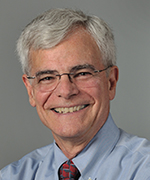From the Deputy Director for Intramural Research
Parenting at NIH: A Delicate Balance

Hanging in my Building One office is a reproduction of a Marc Chagall painting that shows a fiddler carefully poised on two rooftops, managing to stay upright and make beautiful music at the same time. This image represents the challenge bbof being a parent and a scientist at the NIH: How does one maintain equilibrium and productivity while juggling two such important responsibilities?
This issue of the NIH Catalyst addresses this question through a series of interviews with people at the NIH who have been able to manage both parental and scientific responsibilities. Although not interviewed for this issue, my wife Susan and I fall into this category, so I will take the prerogative of the publisher of the Catalyst to offer my two cents about how we managed to survive our child-raising years (recognizing, of course, that each family has its own approach to securing this equilibrium). Here are some ways in which we maintained our careers and our sanity:
We always tried to have more adults than children involved in any activity. One on one is challenge enough; being outnumbered by children is risky. In fact, the more adults that can be brought into the equation, the better. Grandparents, aunts and uncles, friends, neighbors, and professional help are all highly recommended. If they don’t directly help with child care, they can help in other ways: housework, errands, carpools, etc.
Single parents are always at greatest risk and should do their best to engage other adults in the parenting process. I do realize that many people are much better at managing children than we were, but for us, it took a village.
Choose a career with maximum flexibility of hours. You never know when a child will be sick and/or will require attendance at a performance, after-school activity, or help with homework. We are extremely fortunate at the NIH that some of the work we do offers this kind of flexibility, and when it does not (such as an experiment that absolutely must be harvested, or a clinical-care responsibility) then principle #1 applies (a second adult who can step in). Having two parents who both work at the NIH increases the likelihood of flexibility when it is most needed. One of the great recruiting arguments for the NIH is no teaching or required grant-writing responsibilities, both of which are a drain on time otherwise spent with children.
Choose your partner carefully. Romantic attraction is a good start, but willingness for all partners to take on the responsibilities of child care is an absolute essential for any couple who is planning to have children together.
We always tried to set aside some time each day to listen to our children, hear what was on their minds, and give them our best direction. This is easiest to accomplish with a shared dinner time, but can come at bedtime (when we read to our children even through high school) or another relatively quiet time together.
Mentoring of our trainees and junior colleagues at NIH is very different from parenting our own children. Our mentees here seek our advice, try to follow our suggestions, and consider us to be role models. Teenage children do their best to ignore parental advice and seek alternative role models. So we tried never to confuse our children with our mentees; although in both cases we are vitally interested in the outcome of our efforts and want them to succeed, the relationship is very different.
With two scientists in the family, travel to scientific meetings can occasionally interfere with shared parenting. It is important for parents to realize that a scientific trip is an opportunity for one parent to get away from parental responsibilities and focus entirely on science. This can be accomplished by not overwhelming the traveling partner with unpleasant details of events at home or, if the family travels together, having the parent who is not an essential attendee at the meeting take over complete responsibility for the children.
One of the great pleasures in having a career in science and parenting children at the same time is that the children get to see how excited their parents are about their work and how rewarding it is to have a fulfilling career. They get to appreciate that it is possible to love your work and your family, and that the occasional inconvenience of having a parent who is late for dinner or occasionally out of town at a meeting is more than compensated for by having parents who are content with their lives.
We are at the stage now where our children have children, and as grandparents we try as best we can to be those extra helpful adults who can make parenting and a scientific career most rewarding for our children. Many scientists choose not to have children, but those who do develop coping mechanisms such as the ones described in this essay, with perfectly acceptable outcomes, not the least of which is the absolute joy of being a grandparent.
This page was last updated on Thursday, April 7, 2022
